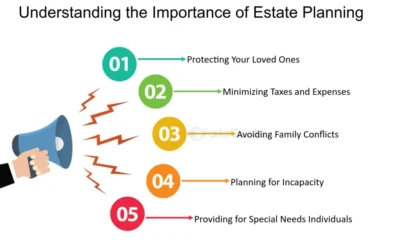Business
The Crucial Role of Logistics Technology in Modern Business Operations
The Crucial Role of Logistics Technology in Modern Business Operations

In the ever-evolving landscape of global commerce, businesses face increasingly complex logistical challenges. From managing inventory and coordinating shipments to optimizing supply chain processes, effective logistics management is essential for success in today’s competitive marketplace. To navigate these challenges and achieve operational excellence, businesses must leverage advanced logistics technology, with a particular focus on third-party logistics (3PL) software. This comprehensive article explores the critical need for logistics technology and the transformative impact of 3PL software on modern business operations.
Understanding the Role of 3PL Warehouses
A 3PL warehouse, or third-party logistics warehouse, is a facility operated by a third-party logistics provider that offers storage and distribution services to businesses. These warehouses are equipped with advanced inventory management systems and logistics technology to efficiently handle and track goods. Businesses can outsource their warehousing needs to a 3PL warehouse to benefit from cost-effective storage solutions, streamlined logistics processes, and access to expertise in inventory management and order fulfillment. With the flexibility to scale operations based on demand and the ability to leverage shared resources, 3PL warehouses play a crucial role in optimizing supply chain efficiency and supporting business growth.
The Imperative Need for Logistics Technology
In an era characterized by rapid technological advancements and shifting consumer expectations, businesses must adapt their logistics strategies to remain competitive and meet evolving customer demands. Here’s why logistics technology is indispensable for modern businesses:
1. Enhancing Efficiency and Productivity
Logistics technology enables businesses to streamline operations, automate manual processes, and optimize workflows, resulting in increased efficiency and productivity. By leveraging advanced software solutions for tasks such as inventory management, order processing, and route optimization, businesses can minimize errors, reduce lead times, and maximize resource utilization.
2. Improving Visibility and Control
Effective logistics management requires real-time visibility and control over the entire supply chain. Logistics technology provides businesses with the tools and capabilities to track shipments, monitor inventory levels, and analyze key performance metrics, empowering them to make informed decisions and proactively address issues as they arise.
3. Meeting Customer Expectations
In today’s on-demand economy, customers expect fast, reliable, and transparent delivery services. Logistics technology enables businesses to meet these heightened expectations by offering features such as order tracking, delivery notifications, and flexible delivery options. By providing exceptional customer experiences, businesses can foster loyalty and drive repeat business.
4. Driving Cost Savings and Operational Efficiency
Effective cost management is crucial for business sustainability and profitability. Logistics technology helps businesses identify cost-saving opportunities, optimize transportation routes, and minimize wastage, leading to significant cost reductions and improved bottom-line performance. By leveraging data-driven insights and analytics, businesses can identify inefficiencies and implement targeted strategies to enhance operational efficiency.
Exploring CartonCloud Management Software
management software CartonCloud software solution designed specifically for logistics and transport businesses. It offers a wide range of features to streamline operations, including order management, warehouse management, transportation management, and invoicing. With CartonCloud, businesses can automate routine tasks, optimize workflows, and improve overall efficiency. The software provides real-time visibility into inventory levels, order status, and delivery tracking, allowing businesses to make informed decisions and provide exceptional customer service. By leveraging CartonCloud, logistics and transport companies can enhance their operations, reduce costs, and drive growth.
The Transformative Impact of 3PL Software
What is 3PL Software?
Third-party logistics (3PL) software is a specialized technology solution designed to facilitate the outsourcing of logistics functions to third-party providers while enabling businesses to maintain oversight and control over their supply chains. 3PL software encompasses a range of features and functionalities, including order management, inventory tracking, warehouse management, transportation management, and analytics capabilities.
Key Benefits of 3PL Software
Streamlined Operations
3PL software streamlines logistics processes, automates routine tasks, and optimizes workflows, enabling businesses to operate more efficiently and effectively. By centralizing operations and providing real-time visibility into logistics activities, 3PL software helps businesses minimize errors, reduce lead times, and improve overall operational performance.
Enhanced Collaboration and Communication
Effective collaboration and communication are essential for successful logistics management. 3PL software facilitates seamless communication and collaboration between businesses and their third-party logistics providers, enabling real-time data exchange, status updates, and performance tracking. By fostering transparent and collaborative relationships, 3PL software helps businesses and their logistics partners align their efforts and achieve common goals.
Improved Customer Service
Exceptional customer service is a key differentiator in today’s competitive marketplace. 3PL software enables businesses to provide superior customer experiences by offering features such as order tracking, delivery notifications, and responsive customer support. By keeping customers informed and engaged throughout the fulfillment process, businesses can enhance satisfaction levels and build long-term loyalty.
Scalability and Flexibility
Scalability and flexibility are essential attributes of successful logistics operations. 3PL software is designed to scale with businesses as they grow and evolve, providing the flexibility to adapt to changing business requirements and market conditions. Whether businesses are expanding into new markets, launching new products, or experiencing seasonal fluctuations in demand, 3PL software can accommodate their needs and support continued growth.
Key Features of 3PL Software
Order Management
3PL software offers robust order management capabilities, allowing businesses to efficiently process orders, track order status, and manage order fulfillment workflows. With features such as order routing, order prioritization, and order allocation, businesses can ensure timely and accurate order processing, leading to improved customer satisfaction and retention.
Inventory Tracking and Management
Effective inventory management is critical for optimizing supply chain performance and minimizing costs. 3PL software provides comprehensive inventory tracking and management features, enabling businesses to monitor inventory levels, track stock movements, and manage stock replenishment processes. By maintaining accurate inventory records and implementing proactive inventory management strategies, businesses can minimize stock outs, reduce carrying costs, and improve inventory turnover rates.
Warehouse Management
Warehouse management is another key aspect of logistics operations that can significantly impact overall efficiency and performance. 3PL software offers advanced warehouse management capabilities, including warehouse layout optimization, inventory slotting, and pick and pack workflows. By optimizing warehouse layout and streamlining picking and packing processes, businesses can maximize storage space utilization, reduce labor costs, and enhance order fulfillment speed and accuracy.
Transportation Management
Transportation management is essential for coordinating the movement of goods from suppliers to customers in the most efficient and cost-effective manner possible. 3PL software provides businesses with the tools and capabilities to manage transportation activities, optimize routes, and track shipments in real-time. With features such as carrier selection, route optimization, and freight tracking, businesses can reduce transportation costs, improve delivery times, and enhance overall supply chain visibility.
Analytics and Reporting
Data-driven decision-making is crucial for optimizing logistics operations and driving continuous improvement. 3PL software offers advanced analytics and reporting capabilities that enable businesses to analyze key performance metrics, identify trends, and gain actionable insights into their logistics processes. By leveraging analytics tools and generating custom reports, businesses can identify areas for improvement, optimize workflows, and make informed decisions to drive operational excellence.
Case Study: Leveraging 3PL Software for Business Success
To illustrate the transformative impact of 3PL software, let’s consider a hypothetical case study:
CartonCloud is a rapidly growing e-commerce retailer that specializes in selling consumer electronics products. As the company expands its product offerings and customer base, it faces increasing challenges with managing its logistics operations effectively. In particular, CartonCloud struggles with order processing delays, inventory stockouts, and rising transportation costs.
To address these challenges, CartonCloud decides to implement a comprehensive 3PL software solution. The 3PL software provides CartonCloud with the following benefits:
- Streamlined Order Management: The 3PL software streamlines CartonCloud’s order processing workflows, enabling faster order fulfillment and improved order accuracy.
- Enhanced Inventory Visibility: With advanced inventory tracking and management features,CartonCloud gains real-time visibility into its inventory levels, reducing the risk of stockouts and overstock situations.
- Optimized Transportation Routes: The 3PL software helps CartonCloud optimize its transportation routes, reducing transportation costs and improving delivery times.
- Data-Driven Insights: By leveraging analytics tools and generating custom reports, CartonCloud gains valuable insights into its logistics performance, enabling continuous improvement and optimization.
As a result of implementing the 3PL software, CartonCloud experiences significant improvements in its logistics operations, including:
- Reduced order processing times
- Decreased inventory holding costs
- Lower transportation costs
- Improved customer satisfaction and retention
Conclusion
In conclusion, logistics technology, particularly third-party logistics (3PL) software, plays a vital role in modern business operations by streamlining supply chain processes, enhancing visibility and control, and driving efficiency and cost savings. By leveraging the advanced features and capabilities of 3PL software, businesses can optimize their logistics operations, improve customer satisfaction, and achieve sustainable growth in today’s competitive marketplace. As the complexity of supply chains continues to increase, investing in logistics technology has become essential for businesses seeking to remain agile, responsive, and competitive in the digital age. By embracing innovative solutions and harnessing the power of 3PL software, businesses can position themselves for success and thrive in an increasingly complex and dynamic business environment.
Business
Discover the Future of Online Shopping with Aliasshare.Shop in 2024

In the dynamic world of e-commerce, new platforms are constantly emerging, each striving to revolutionize the shopping experience by addressing common challenges with innovative solutions. Among these, Aliasshare.Shop has quickly garnered attention as a leading force. This cutting-edge online marketplace distinguishes itself through seamlessly integrating convenience, variety, and high-level customer interactions. Let’s explore what sets Aliasshare.Shop apart in the bustling online shopping scene.
The Rise of Aliasshare.Shop in 2024
Online shopping has become an integral part of our lives, and 2024 is no exception. With more consumers turning to the internet for their shopping needs, the demand for exceptional e-commerce platforms has never been higher. Aliasshare.Shop has risen to meet this demand, offering a unique blend of features that cater to both casual shoppers and dedicated e-commerce enthusiasts.
From its inception, Aliasshare.Shop aimed to create a platform that not only met but exceeded customer expectations. By focusing on user experience, product quality, and customer service, it has quickly become a go-to destination for online shoppers looking for reliability and innovation.
What Sets Aliasshare.Shop Apart from Other E-Commerce Platforms
In a crowded market, standing out is no easy feat. However, Aliasshare.Shop has managed to carve out a niche for itself by offering features that truly set it apart from other leading e-commerce platforms. Let’s take a closer look at some of these unique attributes:
Innovative Shopping Features
One of the standout features of Aliasshare.Shop is its innovative shopping tools. From augmented reality (AR) previews to personalized recommendations based on user behavior, the platform leverages cutting-edge technology to enhance the shopping experience. These features not only make shopping more enjoyable but also help users make informed purchasing decisions.
Seamless Integration of Social Commerce
Aliasshare.Shop has successfully integrated social commerce into its platform, allowing users to share their favorite products with friends and family directly from the site. This social integration fosters a sense of community and makes shopping a more interactive experience.
Exclusive Partnerships and Collaborations
Through exclusive partnerships with top brands and influencers, Aliasshare.Shop offers unique products and collaborations that cannot be found anywhere else. These partnerships add an element of exclusivity to the platform, attracting shoppers who crave unique and limited-edition items.
Enhancing User Experience (UX) and User Interface (UI)
A seamless and enjoyable user experience is crucial for any successful e-commerce platform. Aliasshare.Shop excels in this area by focusing on both UX and UI to simplify the buying process and make it as intuitive as possible.
Intuitive Navigation
Navigating through Aliasshare.Shop is a breeze, thanks to its well-organized categories and clear, concise menus. Users can easily find what they’re looking for without feeling overwhelmed by too many options.
Personalized Shopping Experience
By utilizing advanced algorithms and data analytics, Aliasshare.Shop tailors the shopping experience to individual users. Personalized product recommendations, tailored content, and targeted promotions ensure that each user feels valued and understood.
Smooth Checkout Process
A complicated checkout process can lead to cart abandonment. Aliasshare Shop addresses this issue by offering a streamlined, user-friendly checkout process that minimizes friction and ensures a smooth transaction from start to finish.
A Diverse Range of High-Quality Products
Product variety and quality are at the heart of Aliasshare Shop’s success. The platform offers an extensive range of products that cater to various tastes and preferences, ensuring that every shopper can find something they love.
Curated Collections
Aliasshare Shop features carefully curated collections that highlight the best products in different categories. These collections are regularly updated to reflect current trends and seasonal favorites, making it easy for users to discover new and exciting items.
Quality Assurance
Quality is a top priority at Aliasshare Shop. Each product goes through rigorous quality checks to ensure that it meets the platform’s high standards. This commitment to quality ensures that customers receive products that are not only stylish but also durable and reliable.
Sustainable and Ethical Sourcing
In today’s world, consumers are increasingly conscious of the environmental and ethical impact of their purchases. Aliasshare Shop addresses these concerns by offering products that are sustainably and ethically sourced. This commitment to responsible sourcing resonates with environmentally conscious shoppers and sets the platform apart from competitors.
Exceptional Customer Service and Community Engagement
Customer satisfaction is at the core of Aliasshare.Shop’s mission. The platform goes above and beyond to ensure that customers have a positive shopping experience and feel valued and appreciated.
Responsive Customer Support
Aliasshare.Shop offers a responsive and helpful customer support team that is available 24/7 to assist with any inquiries or issues. This level of support ensures that customers feel confident and supported throughout their shopping journey.
Building a Loyal Community
Aliasshare.Shop understands the importance of building a loyal customer base. Through engaging content, interactive social media campaigns, and exclusive loyalty programs, the platform fosters a sense of community among its users.
Customer Feedback and Improvement
Feedback from customers is invaluable for continuous improvement. Aliasshare.Shop actively seeks out and acts on customer feedback to enhance its platform and offerings. This commitment to listening and adapting ensures that the platform remains relevant and customer-centric.
The Future of Online Shopping with Aliasshare.Shop
As we look to the future, it’s clear that AI and machine learning will play a pivotal role in shaping the e-commerce landscape. Aliasshare Shop is already leveraging these technologies to provide a superior shopping experience, and its innovative approach is set to redefine online shopping in 2024 and beyond.
AI-Powered Personalization
AI-powered personalization is at the forefront of Aliasshare Shop’s strategy. By analyzing user data and behavior, the platform can deliver highly personalized recommendations and content, creating a shopping experience that feels tailored to each individual.
Virtual Reality Shopping
Virtual reality (VR) is poised to revolutionize online shopping, and Aliasshare Shop is leading the charge. With VR capabilities, users can explore virtual stores, try on products, and make purchases in an immersive environment, bridging the gap between online and in-store shopping.
Sustainable E-Commerce Practices
Sustainability will continue to be a major focus for Aliasshare Shop. The platform is committed to reducing its environmental footprint through eco-friendly packaging, carbon-neutral shipping options, and sustainable product offerings.
SEO and Marketing Strategies for Increased Engagement
Effective SEO and digital marketing strategies are essential for driving traffic and increasing engagement on any e-commerce platform. Aliasshare.Shop employs a range of techniques to ensure that it remains visible and attractive to potential customers.
Content Marketing
Content marketing is a key component of Aliasshare.Shop’s strategy. The platform regularly publishes high-quality blog posts, videos, and social media content that educates and entertains its audience. This content not only drives traffic but also builds brand authority and trust.
Influencer Collaborations
Collaborating with influencers is a powerful way to reach new audiences and build credibility. Aliasshare.Shop partners with influencers in various niches to showcase its products and highlight the unique features of the platform.
Search Engine Optimization (SEO)
SEO is critical for ensuring that Aliasshare.Shop ranks highly in search engine results. The platform employs a range of SEO techniques, including keyword optimization, high-quality backlinks, and on-page SEO, to improve its visibility and attract organic traffic.
YOU MAY ALSO LIKE
Discover Tuambia the Premier Selection of Products with Delivery in Cuba
Conclusion
In the competitive world of online shopping, Aliasshare.Shop stands out as a leader in innovation, quality, and customer service. Its cutting-edge features, extensive product range, and commitment to sustainability make it a go-to destination for tech-savvy consumers and e-commerce enthusiasts alike. By continuously improving and adapting to the needs of its users, Aliasshare.Shop is set to shape the future of online shopping in 2024 and beyond.
Frequently Asked Questions
1. What makes Aliasshare.Shop stand out from other online shopping platforms?
Aliasshare.Shop stands out due to its AI-powered personalization, virtual reality shopping experiences, sustainable sourcing practices, and exceptional customer service.
2. How does Aliasshare.Shop ensure product quality?
Each product undergoes rigorous quality checks to meet the platform’s high standards for durability, reliability, and style.
3. What is AI-powered personalization on Aliasshare.Shop?
AI-powered personalization analyzes user data to provide tailored recommendations and content, creating a customized shopping experience.
4. How can I explore virtual reality shopping on Aliasshare.Shop?
Aliasshare.Shop’s VR capabilities allow users to explore virtual stores, try on products, and make purchases in an immersive environment.
5. What are Aliasshare.Shop’s sustainability practices?
Aliasshare.Shop commits to eco-friendly packaging, carbon-neutral shipping, and ethically sourced products to reduce its environmental footprint.
Business
Why Air Duct Cleaning in San Antonio is Essential for Your Health and Home

Indoor air quality is an often-overlooked aspect of home maintenance, but it plays a crucial role in both health and comfort. In cities like San Antonio, where dust, allergens, and humidity are common, the cleanliness of your home’s air ducts becomes even more significant. If your HVAC system is circulating dirty air, it could be affecting more than just your comfort — it could also impact your well-being.
Understanding Air Duct Systems
Your HVAC (Heating, Ventilation, and Air Conditioning) system works like the lungs of your home. It draws in air, heats or cools it, and then redistributes it throughout your living space. Over time, dust, dirt, pollen, pet dander, and even mold spores can build up within these air ducts. Every time your system runs, these particles may be released into the air you breathe.
This buildup not only decreases air quality but also forces your HVAC system to work harder, potentially increasing your energy bills and reducing the lifespan of your system. Keeping your air ducts clean is a simple way to enhance your system’s efficiency and improve the overall indoor environment.
The Health Impacts of Poor Indoor Air Quality
When air ducts are dirty, they can contribute to a range of health issues. Allergens, bacteria, and other contaminants can cause respiratory problems, especially for those who already suffer from asthma, allergies, or other breathing conditions. Children and elderly individuals are particularly susceptible to these airborne pollutants.
Signs that your air quality might be compromised include:
- Frequent sneezing or coughing indoors
- Worsening allergy or asthma symptoms
- Persistent headaches or fatigue
- Moldy or dusty odors when the HVAC system is running
Routine air duct cleaning can help remove these irritants and create a healthier living space for you and your family.
Energy Efficiency and Cost Savings
Dirty air ducts can restrict airflow, forcing your HVAC system to work harder to maintain your desired temperature. This inefficiency can lead to higher utility bills and unnecessary wear and tear on your equipment. Clean air ducts help restore peak performance to your HVAC system, potentially saving you money in the long term.
In fact, the U.S. Department of Energy estimates that homeowners can save up to 20% on their energy bill simply by improving the efficiency of their HVAC system — and duct cleaning is one of the easiest ways to do just that.
When Should You Clean Your Air Ducts?
There isn’t a one-size-fits-all timeline, but the National Air Duct Cleaners Association (NADCA) recommends having your air ducts inspected and cleaned every three to five years. However, you may need more frequent cleaning if:
- You’ve recently completed a home renovation
- You have pets that shed
- You or a family member suffers from allergies or respiratory issues
- You notice visible mold growth inside ducts or HVAC components
- Your home has been recently affected by smoke or water damage
Additionally, if you’re moving into a new home, it’s wise to schedule an air duct inspection to ensure you’re starting with a clean system.
Choosing the Right Air Duct Cleaning Service
Not all duct cleaning services are created equal. It’s important to hire a company that uses professional-grade equipment and follows industry standards. Look for services that offer a comprehensive cleaning process, which includes inspecting all components of your HVAC system and removing debris from every part of the ductwork.
Transparency is also key. A trustworthy service will be upfront about their methods, provide before-and-after photos, and give you a clear estimate before starting work.
If you’re looking to improve your indoor air quality, air duct cleaning San Antonio is an essential service to consider. It’s a small investment that can lead to long-term benefits for both your health and your wallet.
Final Thoughts
Maintaining a clean and efficient HVAC system is more than just a matter of comfort — it’s a matter of health. With rising concerns about air quality and airborne contaminants, taking proactive steps like regular duct cleaning can help ensure that the air inside your home is as clean and safe as possible.
Whether you’re dealing with allergies, noticing a spike in your energy bills, or simply want to create a cleaner environment for your loved ones, professional air duct cleaning is a worthwhile step toward a healthier home. In San Antonio, where climate and environmental factors can accelerate duct buildup, staying ahead of the issue can make all the difference.
Business
Why Your Business Needs an Agency for Google Ads — Not Just a Freelancer

In today’s competitive online space, Google Ads can deliver fast, measurable results. But while many businesses turn to freelancers for quick fixes or cost savings, the real advantage comes from partnering with an agency Google Ads expert who can offer a full-service, strategic approach. If you’re looking to scale, stay ahead of trends, and get the best return on your ad spend, working with an agency is the smarter move.
The Limitations of Going Solo
Freelancers often focus on implementation, not long-term strategy. While they may manage individual campaigns well, most lack the resources to support a truly integrated and scalable Google Ads program.
Common Freelancer Challenges:
- Narrow skill sets or limited platform expertise
- Reactive rather than proactive campaign management
- No access to shared insights, testing frameworks, or creative teams
- Limited bandwidth during peak seasons or multi-channel rollouts
What You Gain with an Agency Partner
A Google Ads agency offers more than just technical execution. You gain a team that can handle everything from campaign architecture and creative production to data analysis and optimisation.
Full-Service Strategy
Agencies take a holistic view of your digital marketing, aligning Google Ads with SEO, landing page experience, conversion tracking, and remarketing funnels.
Advanced Tools and Insights
Agencies invest in premium tools, AI-driven bidding systems, and multi-platform analytics to optimise your performance across every touchpoint.
Scalable Support
Whether you need to ramp up for a product launch or diversify into multilingual campaigns, an agency has the capacity and talent to scale with your goals.
Creative That Converts
From dynamic ad creative to tailored landing pages, agency teams bring together designers, copywriters, and conversion specialists to build high-impact assets.
Why This Matters for Growth
When your business starts to grow, the cracks in a freelance-led approach start to show. An agency gives you structured campaign oversight, continuity, and a team of specialists who can adapt and innovate with you over time.
Cost vs. Value
Freelancers may seem cheaper up front, but missed opportunities, underperformance, or unoptimised spend can quickly outweigh the initial savings. Agencies focus on long-term ROI, not just cost control.
Grow Smarter, Not Just Faster
If you’re serious about scaling, it’s time to think bigger than task outsourcing. Partnering with an agency for Google Ads unlocks deeper strategy, more consistent performance, and expert support every step of the way.
The digital ad space is only getting more competitive — and your business deserves more than short-term solutions.
-

 Education6 months ago
Education6 months agoMastering Excel: Your Comprehensive Guide To Spreadsheets And Data Analysis
-

 Tech9 months ago
Tech9 months agoHow To Choose The Best Forex Trading Broker?
-

 Business1 year ago
Business1 year agoExploring the Rental Market: Properties for Rent in Malta
-

 Blog6 months ago
Blog6 months agoArab MMA Fighters Shine Bright: Meet the Champions of PFL MENA
-

 Travel10 months ago
Travel10 months agoExperience the Best Desert Safari Dubai Offers!
-

 How-To Guides1 year ago
How-To Guides1 year agoComprehensive Guide to Cockwarming: Enhancing Intimacy and Connection
-

 Home Improvement1 year ago
Home Improvement1 year agoEco-Friendly Round Rug Options for Sustainable Living in NZ
-

 Apps and Games1 year ago
Apps and Games1 year agoDiscover Tickzoo: The Ultimate Platform for Video Content Lovers and Creators












